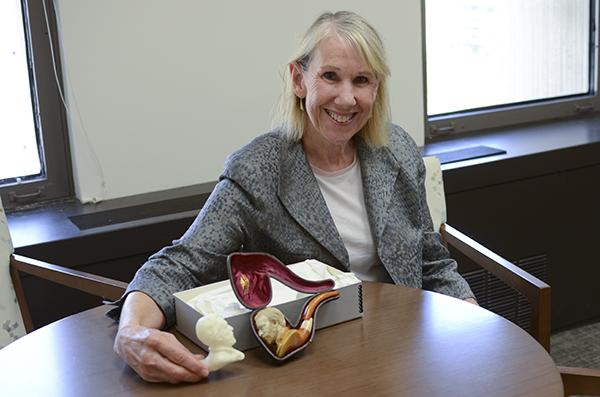
Updated: Sept. 3, 2015 at 11:01 .m.
Gelman Library is getting a tech upgrade.
The library will unveil two 3-D printers later this month, University Librarian Geneva Henry said in an interview. The printers are part of a larger plan to expand technology in Gelman Library, including digitizing archives, updating computers and offering technology workshops.
All GW students will have access to the printers on the entrance floor of Gelman Library starting Sept. 15. Students will pay 5 cents per gram to print objects, Henry said.
Henry said 3-D printing is “pretty crazy,” as she showed a 3-D model of a pipe shaped like Ulysses S. Grant from the University’s archives, printed from the new resources.
Students will be able to submit requests for printing using an online forum, and print jobs will be prioritized by whether it is for a course or a class project, or how long it will take to print the item. Henry said students can print anything they can get the dimensions for.
The printers were paid for through a collection of donations. Henry said she has made it a priority to use library donations to add resources that respond to students’ interests. The 3-D printers were chosen after students widely supported adding them to the library in an online survey specifically asking students about 3-D printing last year.
“We looked at what gift funding we already had because we really try to focus that gift funding on meeting student needs and enhancing their experience here,” Henry said.
Gelman has not received any major gifts in recent history, but did see its budget for collections increase by $300,000 last year, the first increase for that budget in a decade that brought it to a total of $4 million annually. Each student also has a $50 optional library gift in their annual student bills.
Henry said most donations are left up to library administrators’ discretion, and they choose to put the money toward what students want via surveys and satisfaction reviews by students.
3-D printers have been available to students in the School of Engineering and Applied Science in the past, but the new Gelman printers are accessible to students from all schools.
“We want to make sure we are consistent in technologies throughout campus,” Henry said.
Technology upgrades in GW’s libraries have been a priority for Henry since she was chosen for her position in 2013. Last year, she called for upgraded labs and technology in Gelman.
Over the summer, software on some of the computers in Gelman was updated using donated money, bringing technological resources up to students’ standards.
And this semester, information sessions on technology will be offered to introduce students to how to use 3-D printers and other technology resources in the library. Henry said some of those sessions could include learning how to use geographic information systems and help students to learn the basics for multimedia production.
“We’re focusing on using new technologies to facilitate communication,” Henry said.
John Buschman, the dean of university libraries at Seton Hall University, said a lot of universities are investing more in library technologies. He said he sees more benefits from small upgrades to simpler technology and offering information sessions, rather than purchasing glitzier and more cutting-edge technology, like the 3-D printers.
“Students are using technology to communicate with one another and that’s how they’re processing information, and I’d like to see us walk before we run,” Buschman said.
He added that GW’s peer school, American University, recently added new editing and multimedia technology to help students produce digital and multimedia projects.
“I’d rather spend money on the simpler technologies rather than big cutting-edge stuff,” Buschman said. “I’m not sure a library is the best place for a 3-D printer, even though students may gather there.”
This post was updated to reflect the following correction:
The Hatchet incorrectly reported that printing would cost 50 cents per gram. It will cost 5 cents per gram. We regret this error.







